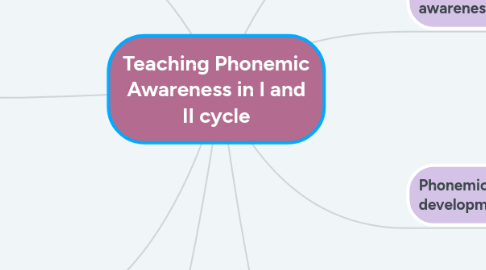Teaching Phonemic Awareness in I and II cycle
by Amanda T


1. Main Concepts
1.1. Phonological Awareness understanding of the sound structure of language—that is, that language is made up of words, syllables, rhymes, and sounds (phonemes).
1.2. Phonemic Awareness It refers to knowledge of words at the level of individual sounds how to segment, blend, or manipulate individual sounds in words.
1.3. Phonics understanding of the sound and letter relationships in a language.
2. Why is it important
2.1. Because a strong understanding of phonemic concepts must be solidly in place prior to formal instruction in reading. It is critical that a child make the association that words on the page are simply “talk written down.”
3. Phonemic Awareness Interactions in the classroom
3.1. Phoneme Isolation
3.2. Phoneme Identity
3.3. Phoneme Categorization
3.4. Phoneme Blending
3.5. Phoneme Segmentation
3.6. Phoneme Deletion
3.7. Phoneme addition
3.8. Phoneme substitution
4. Examples of phonemic awareness skills
4.1. Sound and word discrimination
4.2. Rhyming
4.3. Syllable splitting
4.4. Blending
4.5. Phonemic segmentation
4.6. Phoneme deletion
4.7. Phoneme manipulation
5. What's phonemic awareness?
5.1. Phonemic awareness is the ability to hear, identify, and manipulate individual sounds-phonemes-- in spoken words.
6. Differences between phonemic awareness and phonetics
6.1. Phonemic awareness: Main focus is on phonemes/sounds
6.2. Phonetics: Main focus is on graphemes/letters
7. Phonemic awareness development continuum
7.1. Word comparison
7.2. Rhyming
7.3. Sentence segmentation to
7.4. Syllable segmentation & blending
7.5. Onset-rime blending & segmentation
7.6. Blending & segmentation individual phonemes
7.7. Phoneme deletion & manipulation
8. How to teach phonemic awareness in the classroom: teaching strategies
8.1. Sound and word discrimination
8.1.1. The student: Tells whether words and sounds are the same or different Identifies which word is different Identifies different speech sound
8.2. Rhyming
8.2.1. The student: Identifies which words rhyme Produces a word that rhymes
8.3. Blending
8.3.1. The student: Orally blends syllables or onset-rimes Orally blends separate phonemes
8.4. Segmentation
8.4.1. The student… Claps words in sentences Claps syllables in words Says syllables Identifies first sound in 1-syllable words.
8.5. Sound Isolation
8.5.1. The student: Identifies initial sound in 1-syllable words Identifies final sound in 1-syllable words Identifies medial
